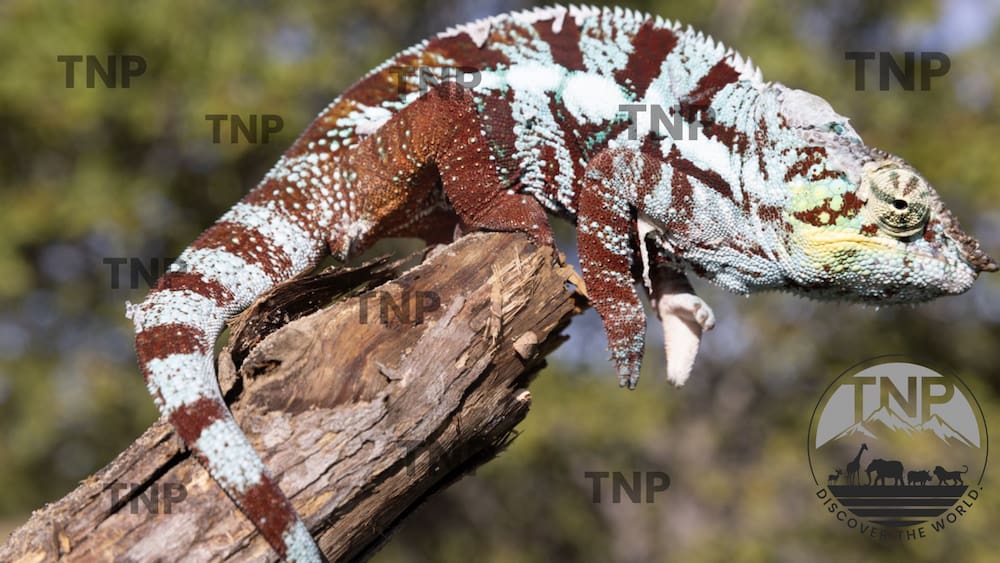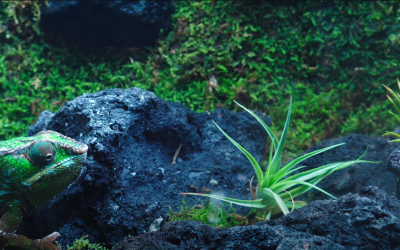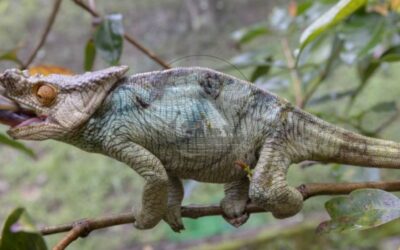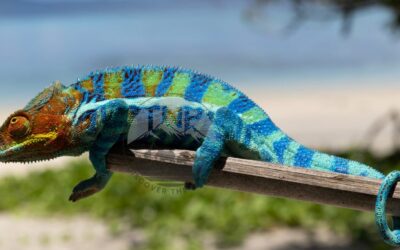All About Panther Chameleons: A Popular Pet Lizard
Panther chameleons, also known as Furcifer Pardalis, are fascinating reptiles renowned for their beautiful array of colors and extraordinary capacity for color change. They are native to the northern and eastern coast of Madagascar and thrive in hot and humid environments.
However, owning a Panther Chameleon requires a certain level of dedication and understanding of its unique needs. In this blog, we explore the fascinating world of Panther chameleons, investigating their anatomy, behavior, natural environment, and the challenges that pet owners face.
Before I start, if you want to learn about other Madagascar chameleons, click here!
Anatomy and Characteristics of Panther Chameleons
These chameleons exhibit a wide range of physical features and size variations. Panther chameleons are bigger than others, reaching lengths up to 50 cm. Males are generally larger than females. Their body length can range from 10 to 18 inches, averaging around 140 to 180 grams in weight.
Panther chameleons have five toes. However, they are fused in two groups, one with three and the other with two. Their feet are frequently characterized as resembling tongs. This aids in their grasping of branches. They also have a flexible tail that can be used to offer support.
Panther Chameleons possess unique attributes, including independently mobile eyes that can focus in different directions simultaneously. Their prehensile tail serves as a fifth limb, offering climbing stability and grip.
One of their most remarkable features is their ability to change colors, which serves as a form of communication and indicates sexual readiness, health, and geographic origin.
Appearance
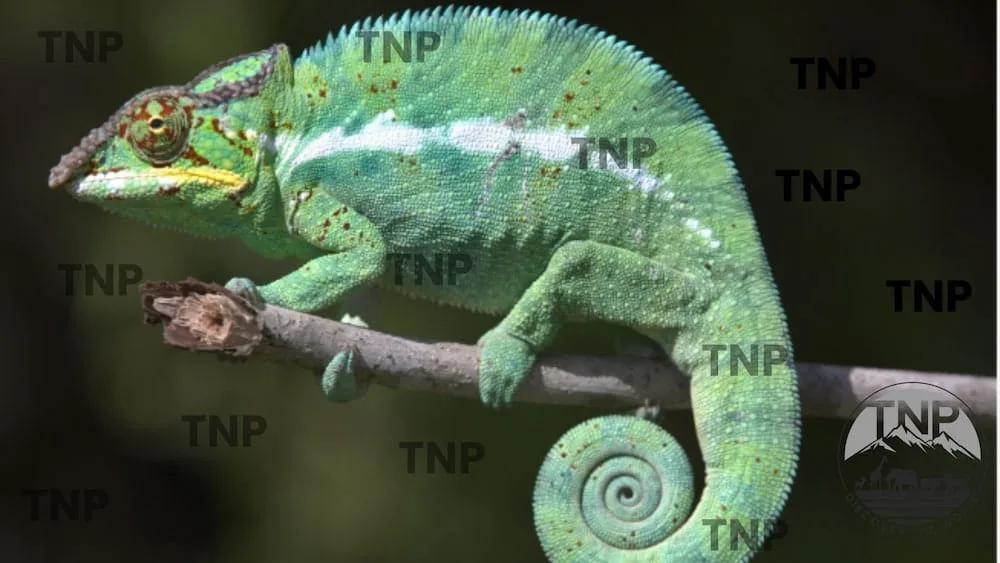
Panther chameleon’s colors have a lot of variety, including blue, red, green, and orange. Males are primarily blue and green, though you may occasionally find a black panther chameleon. It depends on the location where it originates.
Females usually are tan and brown with touches of pink, peach, or brilliant orange, regardless of where they are found. However, as the circumstances alter, so do their appearances. Here is a chart that illustrates how color changes with the situation.
| Color | Reasons for Changing Appearance |
| Darker colors: brown, black, or even dark green. | Stress |
| Brighter colors: green, red, and blue | Excitement |
| Black color | Fear |
| Neutral color | Relaxed |
| Red | Angry |
| Orange or Red | Mating/ courtship |
How Does Panther Chameleon Change Their Color?
Panther chameleons change their color through a cryptic coloration process. We all know that Chameleons often change their color, but the question is, how do they do that?
To answer that question, we must talk about the panther chameleon’s outermost layer of transparent skin, beneath which lie several layers of specialized cells known as chromatophores. These chromatophores contain pigments and nanocrystals that are crucial in color transformation.
The deeper layers contain melanophores filled with brown melanin, while atop them are cells called iridophores, which include blue pigments that reflect blue and white light. In addition, some xanthophores and erythrophores contain yellow and red pigments, respectively.
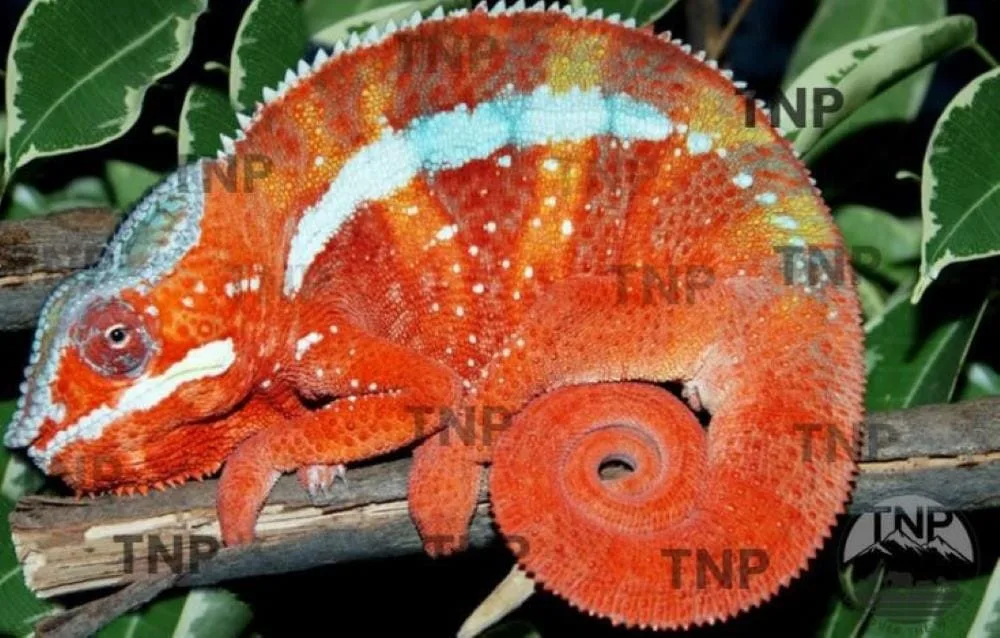
The pigments in these chromatophores are stored within sacs within the cells. When a chameleon experiences changes in body temperature, mood, or environmental conditions, its nervous system sends signals to specific chromatophores to expand or contract.
This adjustment in the activity of chromatophores changes the color of the chameleon’s skin, enabling it to produce a wide range of colors and patterns.
Behavior and Lifestyle
Panther chameleons exhibit diurnal behavior, indicating they are most active during daylight hours. They engage in tree-dwelling activities throughout the day, such as foraging for insects. As arboreal creatures, they predominantly inhabit trees rather than the ground.
Male panther chameleons display strong territorial tendencies, diligently patrolling and safeguarding their territories against other males. The size of a male’s territory correlates with its productivity, offering diverse food sources.
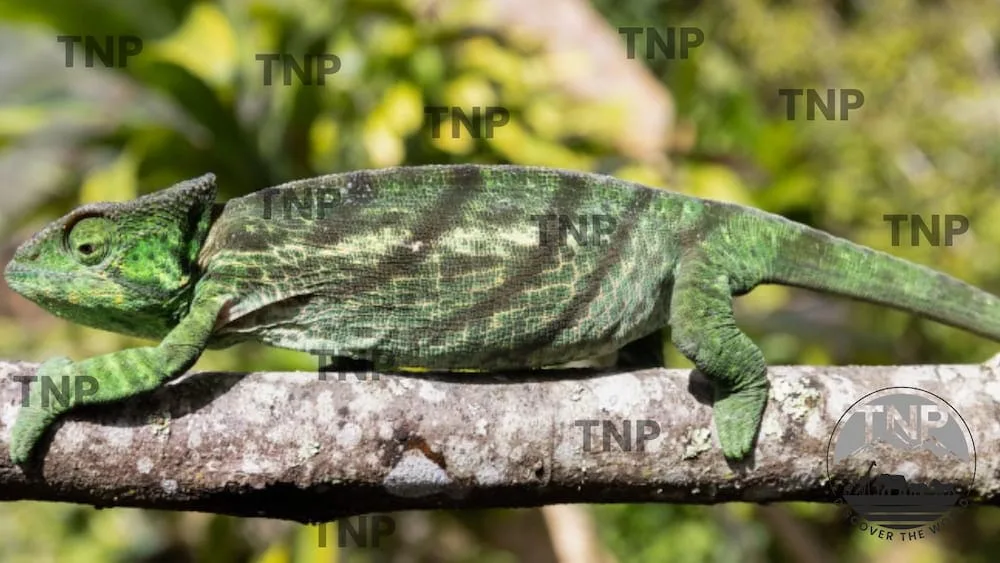
These chameleons are characterized by deliberate, slow movements, with each step taken with careful consideration. The swiftest aspect of their movement is their elongated tongue, which resembles that of a frog.
Chameleon’s tongue is specialized for swiftly capturing prey from the air and ground. Impressively, their tongue can extend up to one to two times their body length.
Habitat
If you’re considering bringing a vibrant and captivating panther chameleon into your home as a pet, it’s important to create an environment that truly reflects its unique habitat in the northern and sea-level regions of Madagascar.
These charming creatures thrive in the lush embrace of trees and bushes, particularly in the warm and humid coastal lowlands. To ensure the well-being and happiness of your panther chameleon, it’s essential to be mindful of its sensitivity to environmental changes.
These changes can induce stress in these delicate beings, impacting their overall health and vitality. That’s why it is essential to provide them with a habitat that faithfully mimics their natural abode.
Housing Panther Chameleons As A Pet
Housing Panther Chameleons can be a delightful experience! You must create a cozy habitat with live plants, branches, and a misting system. These colorful reptiles thrive in warm, humid environments, so keep their terrarium well-lit and moist.
Providing a balanced diet of insects and supplements ensures their health. Regular vet check-ups and a clean living space guarantee happy, vibrant Panther Chameleons!
Enclosure
Due to their large size overall, keeping an enclosure that’s big enough is crucial. Remember that these chameleons prefer to live higher than the forest floor. Thus, your tank should extend more vertically than horizontally.
For a full-grown panther chameleon, we highly recommend providing them with a spacious enclosure measuring at least 90x45x90cm (36x18x36″). Of course, if you can offer an even roomier habitat, your chameleon friend will undoubtedly find it delightful.
Opting for a glass terrarium is preferable due to their elevated humidity needs, as wooden setups might not withstand the test of time. But, while choosing the terrarium, you must consider the temperature and humidity of your living area.
Panther Chameleon’s Heating Process
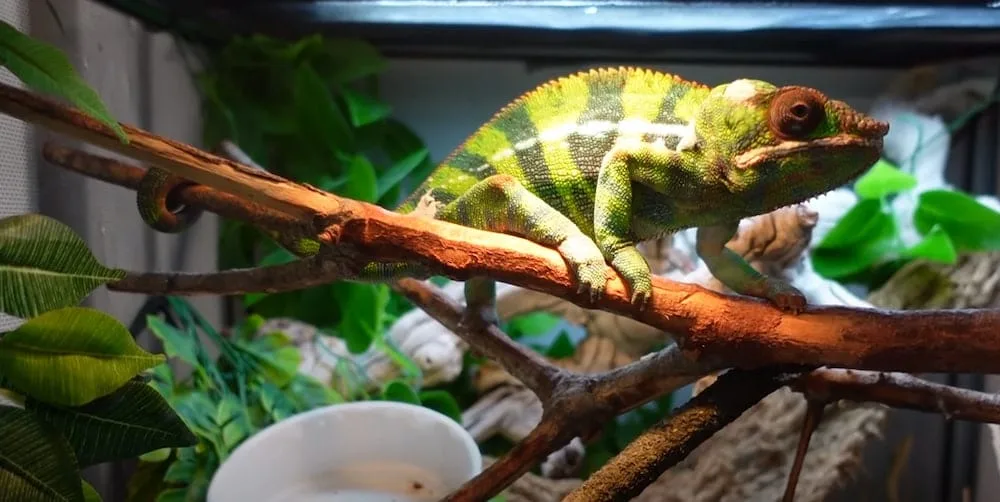
Panther chameleons, native to Madagascar, have a unique natural heating process. In captivity, you must replicate a similar temperature for them to process heat properly. Let’s talk more about these processes.
Natural Heating Process
They change colors to regulate their body temperature. When they need warmth, they turn darker hues to absorb more sunlight. If they’re too hot, they lighten up to reflect excess heat. This fascinating ability helps them stay comfortable, showcasing nature’s incredible adaptations!
Heating Process in Captivity
The steamy, muggy rainforest environments are ideal for panther chameleons. Maintaining a basking temperature of roughly 35°C (95°F) at the terrarium’s topmost point, gradually dropping down to around 22°C (71°F) closer to the floor, is perfect for replicating their native habitat.
Creating an elevated basking area can help you achieve this through a basking lamp or a suspended ceramic heater. Connecting all heating equipment to a compatible thermostat is essential for safe and regulated temperature control.
We recommend a dimming thermostat for a basking light, while a pulse-proportional thermostat is suitable for a ceramic heater.
Although it may be tempting, we don’t advise a heat mat due to enclosure size and orientation. It won’t effectively raise the overall ambient air temperature or establish the necessary temperature gradient required for the well-being of a Panther chameleon. Instead, it would only warm the immediate vicinity around the heat mat.
Unless the ambient temperature in your living space falls below roughly 15°C (59°F) overnight, additional heating is typically unnecessary during nighttime hours.
However, if necessary, a non-illuminating heat source such as a ceramic heater can be utilized, adjusted to lower temperatures than during the daytime, emulating a natural decline in temperature that chameleons experience overnight.
Lighting

To ensure that a Panther chameleon’s vitamin D3 metabolism and calcium absorption from the diet are at their best, pet owners must supply them with a UV index of 3–4. The required UVB light is determined by the distance between the light fixture and the highest point where my chameleon prefers to sunbathe.
You can use a linear fluorescent UVB bulb, preferably a 5.0 or 6.0 strength bulb. But ensure that the UVB bulb covers about two-thirds of the cage’s length and is positioned 10-12 inches above the basking spot.
Also, the Exo Terra Solar Glo provides both heat and UVB in one fell swoop. It provides a warm spot for basking and UVB.
Humidity You Need to Maintain
Panther chameleons need proper humidity to thrive. They’re used to it naturally; we must replicate that when we bring a pet chameleon.
Humidity in Nature
In their natural habitat, lush rainforests provide the perfect moisture levels. Humidity helps keep them hydrated, aids in shedding and maintains their vibrant colors. Mimicking this environment in captivity is vital for their well-being, ensuring they lead happy, healthy lives.
Humidity in Captivity
Panther chameleons are especially sensitive to moisture in their natural setting. Daytime may not necessitate as much attention, as these chameleons prefer 50% to 60% humidity.
However, these levels rise during the night and should be kept between 75% and 100% humidity. As you might expect, keeping track of these humidity levels when sleeping can be difficult.
To that end, you should invest in a humidifier that can run while you sleep. We suggest you use a reptile fogger humidifier that allows you to maintain high humidity levels without needing continual monitoring.
Substrate
You can relax a little since, unlike many other reptiles, panther chameleons do not require many substrates. Because they spend very little time on the ground, the substrate is not the most crucial part of the enclosure.
This means you can use paper towels on the bottom of your enclosure, which can be simply replaced once drenched with water. You might also use dried moss if desired.
Reasons Behind Not Using Substrate
It’s okay to consider using a substrate, but it might not be the best choice for beginners. While it has benefits, the drawbacks, especially for new chameleon owners, are more significant. So, we’ll discuss the drawbacks first, and then we’ll talk about the advantages.
Less Needed
If you have small pets like hamsters or rabbits, you should provide them with hay or sawdust in their cage. These materials help them stay happy and healthy.
But like veiled and panther chameleons, chameleons don’t need these things. They don’t spend much time on the ground, so you don’t have to worry about providing substrate for them.
Causing Impaction
Like most chameleons, Panther chameleons are vulnerable to common illnesses such as stress, eye infections, parasites, kidney failure, and gout. Chameleons have sensitive tummies. Sometimes, they accidentally swallow things that can block their digestion and make them sick. This is called impaction.
Certain things like bark and sand can make this more likely. When chameleons use their long tongues to catch food, they might swallow something by mistake. If this happens, it’s essential to take them to the vet.
Retaining Bacteria
When chameleons live in cages with wet soil or bark, they stay wet because they often need to be sprayed with water. The problem is that this wetness can make bacteria grow, making your chameleon sick. They might get infections and need to see a vet for treatment.
Easy Cleaning
Having paper towels at the bottom of the cage makes cleaning my chameleon’s home easy! If your cage has a removable bottom, like mine, it’s a breeze.
Just slide out the bottom, remove the old paper towels, clean them with reptile-friendly spray, and put in fresh towels. Voila! Clean and cozy for your chameleon.
Reasons Behind Using Substrate
Now, we’ll be talking about the benefits of using substrates–
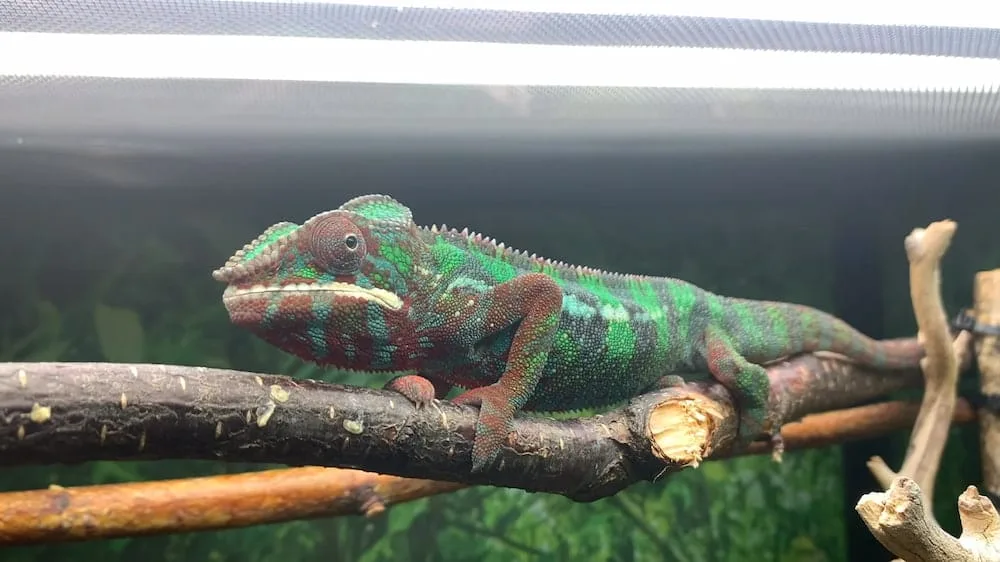
Absorption
Chameleons need to be sprayed with water every day. Special soil helps soak up the water and eliminates the need for a complicated drainage system.
This soil also stops water from collecting at the bottom of the cage, which can make germs grow if it stays there for too long. So, it keeps your pet chameleon healthy and happy!
Humidity
Veiled and panther chameleons need about 50% humidity in their air. Using natural things like soil and live plants, you can keep their habitat humid. These things make it easier to keep the proper humidity for your chameleon.
Egg Laying
If you have a girl chameleon, she might lay eggs even without a boyfriend chameleon. You can give her a unique pot filled with dirt when this happens. She’ll dig in it and lay her eggs there. Or, you can use soil on the ground so she can pick any spot to lay her eggs. Easy peasy!
No Need to clean
Okay, so this mainly works for natural stuff like leaves and soil. Bugs and bacteria in the soil naturally break down chameleon droppings and waste, so you don’t have to clean as much.
But don’t forget to clean dried droppings off leaves! Harmful bacteria can still be a problem and make your chameleon sick, so be careful.
What to Feed Your Panther Chameleon?
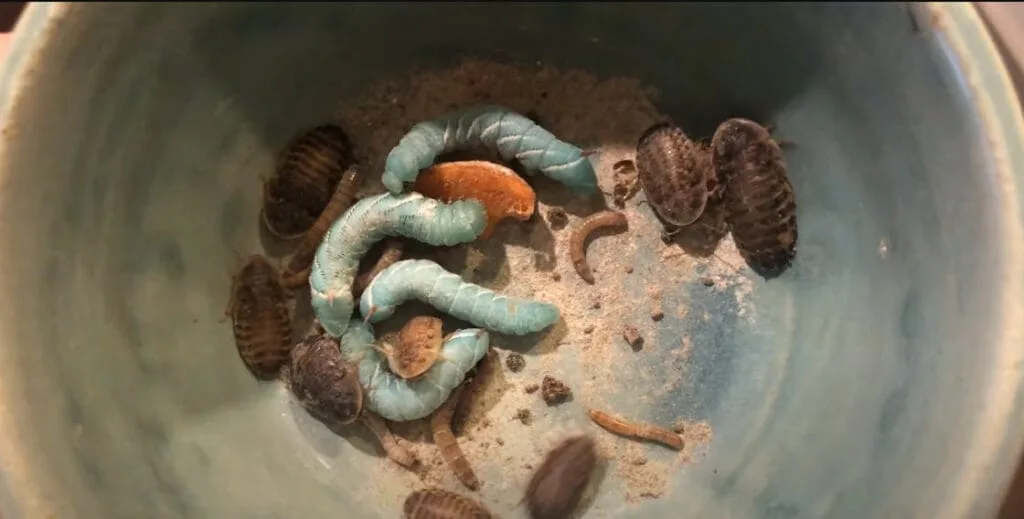
Panther chameleons are insectivores, meaning their diet is heavily based on insects. These chameleons will also love a delectable treat like waxworms, grasshoppers, and silkworms, though most owners prefer to give their pets crickets, Dubia roaches, or mealworms. As one might anticipate from their natural environment, they occasionally love a tough Madagascar roach.
We suggest you gut-loaded insects or dust them with multivitamins before feeding your panther chameleon. Only give your chameleon what he or she can eat in one sitting, ranging from 5 to 15 feeder insects per meal. Adults should be fed every other day, while babies should be fed twice daily. As worms are rich in fat, you should feed them two times a week.
| Chameleon phase | Insect’s Numbers | How many times a day |
| Juvenile | 12-15 crickets | Twice a day |
| Sub-adult | 8-12 crickets/worms | Twice a day |
| Adult | 5-6 crickets | Every other day |
| Gravid (Egg laying) | As much as they can | Everyday |
How to clean Panther Chameleon’s Terrarium?
The only thing you’ll need to do daily is clean the tank on the spot. This includes cleaning up toilet waste and dead bugs that your panther chameleon did not eat.
If you’re using paper towels as your substrate, peeling them out and replacing them every couple of days is simple. We suggest you provide a deeper cleaning by wiping down your panther chameleon’s favorite locations with a sponge soaked in hot water every week.
Panther Chameleon’s Breeding & Reproduction
Panther chameleons exhibit polygynous mating behavior, in which a single male engages with multiple females for reproduction. Breeding patterns can vary based on location, but they typically occur from January to May.
Panther chameleon’s husbandry is very difficult to mimic. When breeding Panther chameleons, pet owners must focus on how mature and ready they are to reproduce captive-bred. Female chameleons should wait until they are approximately 12 months old and 14 to 18 inches long.

They display their adult salmon pink coloration to reduce reproductive stress. Male chameleons usually are ready for breeding at around 8 months old and 10 to 12 inches long.
Pairing adult panther chameleons requires careful consideration. If they are not ready for breeding, they may exhibit apathy or defensive behaviors. The male usually starts head bobbing and approaches the female when they are both ready, and she agrees to the interaction.
After copulation, which lasts for around 15 minutes, the couple is either separated or left together for a few days to maximize the likelihood of success. A well-fed, separated gravid female is essential to decrease stress and supply enough nutrition for egg formation during the roughly 30-day gestation period.
A laying box should be available, though females may pick another spot. During the egg-carrying phase, females adopt a dark brown or black hue adorned with orange stripes. This change serves as a clear signal to males that they are not interested in further mating.
The female’s post-egg laying period spans two to three years, during which they may produce 5 to 8 clutches of eggs. Unfortunately, this relatively short lifespan is attributed to the taxing effects of egg production on their bodies.
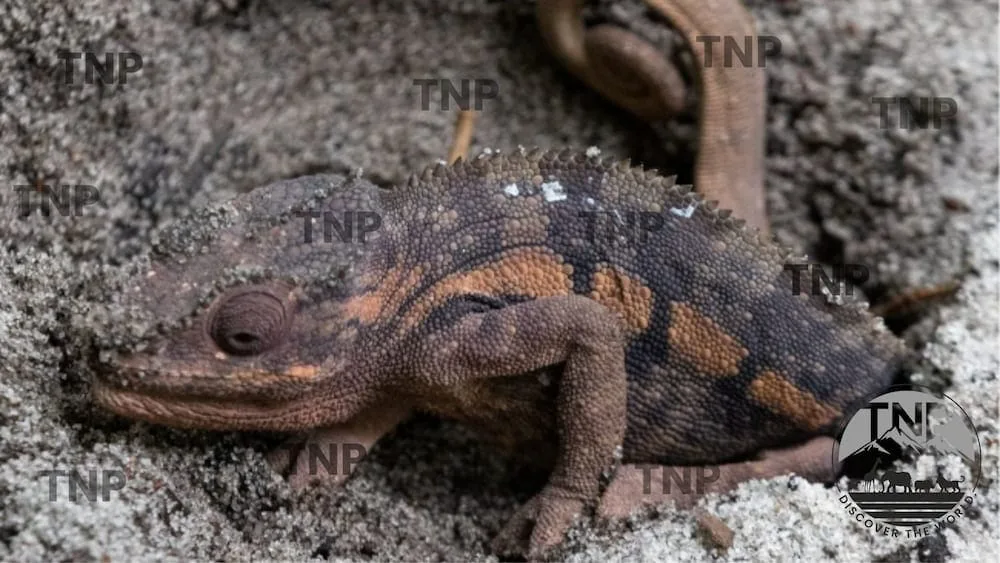
Each clutch of eggs can range from 10 to 40, influenced by the availability of food and nutrients during the developmental phase. These eggs are usually laid in concealed burrows, which incubate for approximately 240 days before hatching.
Upon hatching, the young chameleons are self-sufficient and weigh approximately 0.25 to 0.75 grams. They achieve reproductive maturity by the age of at least seven months.
Panther chameleon hatchlings require similar care to adult chameleons, including regulating humidity, UV index, and temperature in a constrained space. Consistent food availability is essential starting 24 hours after hatching and adhering to the same supplementation schedule as adults.
FAQs of Panther Chameleon
How big do panther chameleons get?
Male panther chameleons can grow to be 21 inches long. However, they are usually 12 to 18 inches long. Females can grow to be 12 to 14 inches long.
What are the types of Panther chameleons?
There are 202 species of panther chameleon, and some of the different types of Panther Chameleons are Ambanja Panther Chameleon, Ambilobe Panther Chameleon, Nosy Be Panther Chameleon, Nosy Faly Panther Chameleon, Sambava Panther Chameleon, etc.
What exactly is a panther chameleon Locale?
The panther chameleon locale is used to determine the origin of your panther. It reflects your pet’s origin, which determines your chameleon’s colors.

